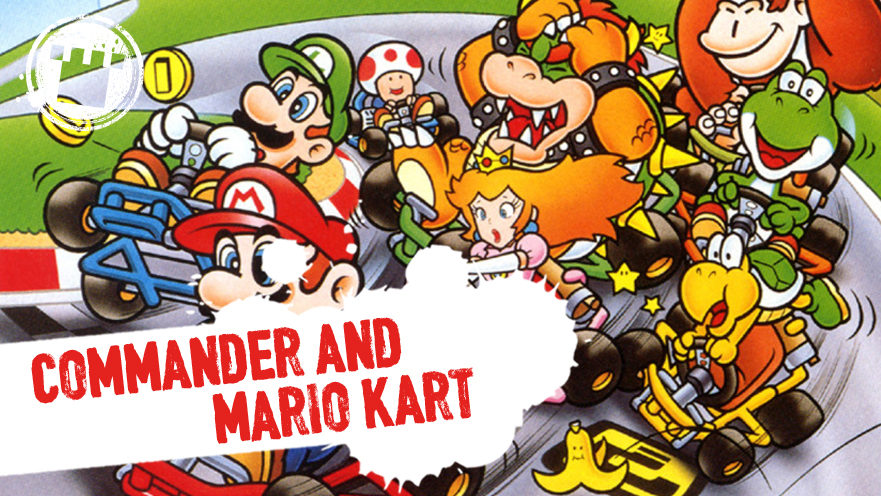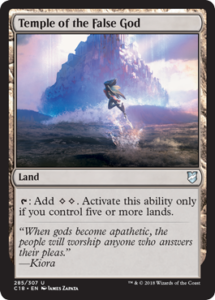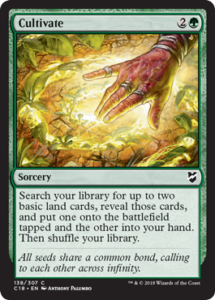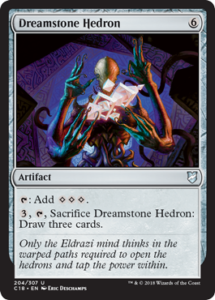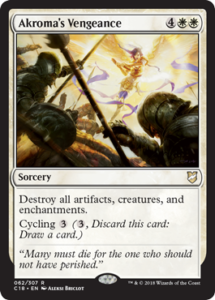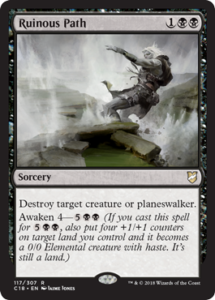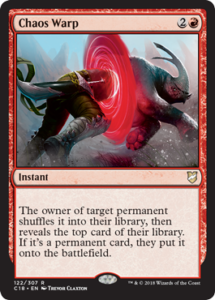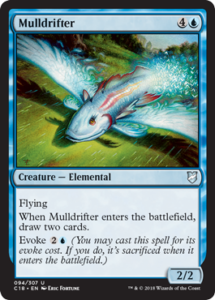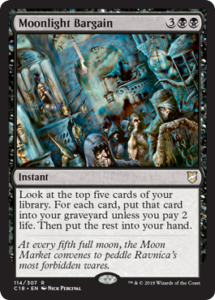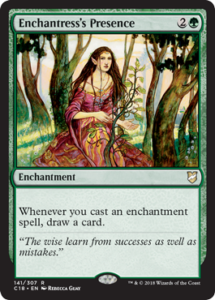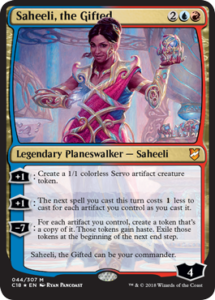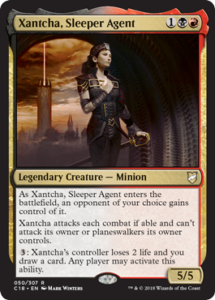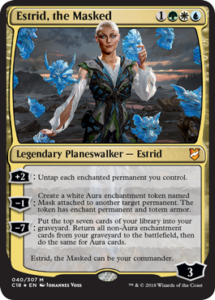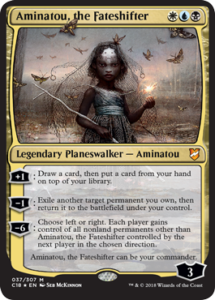If you’re new to Commander, a preconstructed deck is a great way of comprehending and entering the format cheaply. But where do you go from there? How do you build one on your own?
To answer that, I’m taking a look at how Wizards of the Coast built the first six years of Commander preconstructs – 29 decks in all – to get a sense of a basic deck’s parameters. Along the way, I’ll draw parallels from a game that, like Commander, seemed weird at first but grew to be one of the biggest spinoff franchises in history – Super Mario Kart. Why? Because why not?
100cc = 100commandercards
The Super Mario Kart manual helpfully informs us in its introduction (p. 3):
“We race one seater, metal pipe frame go carts here. There are two engine sizes to choose from: 50cc or 100cc. All of the go carts are more or less the same, it’s the individual drivers that make the difference when it comes to winning.”
While Commander deck size autoselects 100 as our engine size rather than 50, the rest is universally true: it’s important to know what a go cart is made of, and it matters who’s in charge.
So what kind of go carts has Wizards of the Coast built? (And why “cart” in the manual and “Kart” in the game name?) They have different shapes, but they boil down to a few things:
50ish cards about mana
Lands, nonlands that make mana, or cards that find lands from your library. The mean number of lands in a Commander preconstruct is 39, and the mean number of mana acceleration/fixing cards is 10, so if you’re starting out dedicate half your cards to helping you cast the other half.
How you allocate between lands and acceleration depends on your deck needs. Mirror Mastery, a 2011 deck led by Riku of Two Reflections, was so mana hungry (thanks to a five-mana commander who wanted to pay extra mana to make copies of big creatures) that it had 41 lands and 18 mana-fixers – a whopping 59 cards! On the extreme opposite end, Political Puppets, another 2011 deck, had 34 lands and six mana-fixers – only 40 cards. All other decks have had between 43 and 55 cards in this category, so stick to that absent a reason to deviate.
In my opinion, it’s best to start with a high land count and low artifact ramp count. I like calling artifact ramp the “stilts” of the format; it can prop up grand things, but it can be knocked out easily. If you’re a competitive Super Mario Kart player trying to set record times, you generally play as Donkey Kong Jr. or Bowser because they have the highest top speeds; but if they hit something, it takes forever to accelerate back up. It’s better when starting out to have easy play control of what you’re piloting – like Koopa Troopa and Toad, recommended by the manual (p. 24) as “good for beginners who are just learning to race” (as opposed to those other beginners, I guess?). Besides, you can gain an edge if, instead of accelerating with artifact mana, you play cards that destroy a lot of artifacts. They don’t hurt you as bad, and you can play them aggressively to make the high-speed players spin out.
15ish removal spells
Defining removal as cards that affect cards on the battlefield, the mean number of removal spells in preconstructs is 15. The low is eight (Stalwart Unity, a deck in the “group hug” archetype that wants to increase everybody’s resources) and the high is 25 (Arcane Wizardry, a Wizard tribal deck that needs that much removal so its 2/2s and 3/4s are the biggest acts in town).
I’m including for this category any permanent you could remove, and I think that’s especially appropriate as you’re learning Commander. Artifact and enchantment sweepers can be just as impactful and – thanks to being less included in decks – make you some friends in a game. Tranquil Grove can do a lot of work on enchantments. The Command Zone podcast recommended Hammer Mage a few episodes ago to deal with artifacts, and it’s as good as they advertise. If you’re in green, anti-flying cards like Whirlwind and Gravity Well can protect you as effectively as a more traditional removal spell can. Put in some basic removal spells to start, then revisit your removal as the rest of your deck comes together and you understand what threats your deck actually fears.
Nineish card draw/tutor spells
This category varies widely among preconstructs, in part because some colors are pretty bad at it. The Jund-colored Power Hungry deck only has one card in this category; the blue-red, spell-heavy Seize Control deck has 19. Don’t put in bad cards just for the sake of drawing cards – Armistice was printed in a monowhite preconstruct out of desperation – but make sure you have ways to refill your tank. I’ve put Jayemdae Tome in many decks without shame, and Core Set 2019 just printed the strictly better Arcane Encyclopedia, so that’s a real option for any of your new decks.
The more you can combine these three categories, the more efficient your deck is. Hedron Archive is ramp and card draw; Decree of Pain is removal and card draw; Unstable Obelisk is ramp and removal. Find more cards like this, and your deck gets better.
Everything else
The remaining cards are where your theme, flavor, and panache come from. Ideally, your ramp, removal, and card draw/tutoring fit in with your theme, but it doesn’t have to when you’re starting out. If your theme is lifegain, then Fumigate is a better removal spell than End Hostilities, but don’t shy away from building the deck if you don’t own a Fumigate yet.
More than making sure you own the exact right cards for a deck, make sure you don’t put infinite high-mana cards in the deck. I recommend that no more than 20 cards cost five or more mana and no more than 12 cards cost six or more mana.
Who’s Driving This Thing?
In Super Mario Kart, you drive a driver; in Commander, you command a commander. Pages 21-25 of the manual discuss three driver attributes:
Acceleration: In Magic, acceleration from zero to max speed would be velocity from an empty hand or swept board – crash recovery. Anything from unconditional card draw to creatures’ death triggers can help in the right context.
Top Speed: How magical is your Christmas Land? When the deck is humming, how epic is it? This attribute’s usually the easiest to spot reading the card and daydreaming.
Steering: The Princess and Yoshi have “[s]ome trouble with the steering wheel,” while Koopa Troopa and Toad are “[g]ood at steering carts.” In Magic, this is probably easiest thought of as versatility – how well can this card respond to unpredictable conditions? The more options, the better the steering in general. Spot removal is also easier to steer than mass removal, given that spot removal basically never kills your stuff but mass removal might.
Combining those things, here are some Commander 2018 commanders that resemble Super Mario Kart drivers:
Mario/Luigi: “Standard Performance”
Saheeli, the Gifted has some acceleration in her Servo tokens, decent top speed in her artifact cost reduction and token-making, and decent steering from having multiple plus-loyalty abilities. Saheeli has enough different strengths to do good work in any basic setting.
Princess/Yoshi: “Fast Acceleration”
Xantcha, Sleeper Agent gets to her top speed (of attacking all the time) quite fast, and her activated ability allows for a lot of acceleration. But after she enters the battlefield, you have no control over her. If her controller wants her to crash into a 6/6, what are you going to do? So there’s a lot of acceleration but low steering ability.
Bowser/Donkey Kong Jr.: “High Top Speed”
Estrid, the Masked does a lot of amazing stuff, but only if you have multiple enchanted permanents. Unless one of the permanents Estrid untaps has an Ocular Halo, there’s little acceleration – Estrid after an empty board is liable to do nothing – even as the steering’s okay from having a few different abilities.
Koopa Troopa/Toad: “The Small Guys”
Aminatou, the Fateshifter has decent acceleration with her plus ability, and her ultimate gives you loads of control, literally steering the battlefield. But what’s the top speed here? What are these abilities useful for? Why would you build a deck and then give its fruits to someone next to you? She won’t hit hard like Jund, but she’s maneuverable – and that can be enough.
What Kinds of Items Are There?
We’ve covered the drivers; now how about the weapons used throughout a race? Turning to page 13 of the manual:
Banana peel

You can toss them, but it takes good aim; they’re mostly to put behind you as an enemy cart is in close pursuit. They don’t cause a full crash, but sometimes the slip is enough to fall behind.
Analog: Tempo plays, especially ones that mess with combat, can count here. Many premium banana peels have debuted in preconstructs, from Illusionist’s Gambit in 2013 to Comeuppance in 2014 to Arachnogenesis in 2015. Reprints like Blustersquall do a good job as well. As with banana peels, you don’t want your arsenal entirely made of these, but a few well-placed ones will make a difference.
Green shell

You can put them behind you like a worse banana peel, or you can fire them. They cause good crashes at close-range, and they can bounce around for awhile if you miss.
Analog: There aren’t many Magic cards that can do close-range work or add chaos if fired blindly. The best of these might be Act of Authority, which allows for immediate removal and then future removal if you give it away. Acidic Slime‘s deathtouch body can be a decent play even if there isn’t a good enter-the-battlefield target; it’s never amazing on its own, but you’re never sad to see it either. It’s also green, so it matches the shell color.
Red shell

The premium targeted removal in Super Mario Kart, as it homes in on the kart immediately in front of you to make it crash. There are ways to dodge it, but it’s as close a guarantee as you’ll get.
Analog: Any targeted removal. Vindicate, Krosan Grip, and Path to Exile are played in large numbers because they do their one-time job well; these are the red shells of Magic, and it’s never bad to have them.
Feather

These allow for jumps, whether for shortcuts or to dodge something on the ground.
Analog: They have corner case uses in Super Mario Kart, and Magic equivalents are also corner-case dodges most of the time. Heroic Intervention strikes me as a feather card, where you get to jump over what was about to affect you. Teferi’s Protection is similar. And depending on what they’re in response to, they can be a shortcut to success. If the board’s about to be wiped but yours suddenly isn’t, you’re ahead a great deal.
Mushroom

It’s a speed boost.
Analog: Ramp cards are the obvious speed boosts, but card draw is another type of speed boost. It’s hard to get going after a crash sometimes, and more cards can pull you back into the mix.
Star

Temporary invincibility that lets you ram into opponents.
Analog: Iroas, God of Victory allows you to ram all your creatures into someone; I love Dolmen Gate for the same purpose. Savage Beating doesn’t prevent damage to your creatures, but you can make a whole lot of the field crash by casting it at the right time.
Ghost

Makes you invisible (letting you dodge some removal) and steals a nearby item.
Analog: Okay, maybe this is where Teferi’s Protection goes. But steal effects are plenty good by themselves in Commander. I prefer ones that don’t require an aura, like Beguiler of Wills, but there are plenty of good options. Clone effects are usually cheaper than the thing they copy; they feel ghost-ish too.
Coin

You can go a bit faster and not spin out just for hitting other players. They’re not that useful.
Analog: Depending on what your deck does, sometimes minor effects like Ponder are worth running. They keep you from hitting an absolute floor of doing nothing, but you don’t jump for joy at getting them either. You often use them up as quickly as possible to find a better item.
Lightning

The only thing in Super Mario Kart resembling a sweeper, as it shrinks all other racers and makes them squishable. You can only get it if you’re in fifth through eighth place, i.e. the bottom half.
Analog: Any board wipe that affects opponents but not you; Cyclonic Rift and In Garruk’s Wake are two of the best, as they slow everyone else down and make you fast by comparison. I think the biggest lesson out of this comparison is to use lightning largely for catching up like in Super Mario Kart, unless it will outright win you the game (like it’s the final lap and you just need to cross the finish line without interference). It’s easy to look at one problematic opponent and use your best removal, but see if others will use their red shells and banana peels before reaching for the biggest and baddest thing you’ve got. Unless you’ve got multiple lightnings in your hand, of course – then feel free.
Of course, lightning and red shells are the most desirable weapons, just as hard removal is best in Commander. But that doesn’t mean other items don’t have a place. Loads of things can be weapons in the right context, and a variety of weapons can keep opponents off-balance.
Conclusion
If you’re new to Commander, let Wizards of the Coast’s deckbuilding and Super Mario Kart guide you. A lot of multiplayer free-for-all games share guiding principles; it’s just a matter of seeing how they’re implemented from game to game. Commander can be intimidating, but if you start knowing the shape of a typical deck and how different things drive, you can build a deck or two to get the feel right and keep up with your opponents.
And who knows – maybe this article helps you play a better Super Mario Kart as well. Worse things have happened.
Note: Super Mario and Super Mario Kart are copyright Nintendo USA.

Brandon Isleib plays a lot of Commander and Brawl and loves finding the intersection of unusual and effective plays. He worked for Wizards of the Coast in 2014, he has put flavor text on a few cards, and he’s partly responsible for “create” being the word for cards making tokens. He is a legislation editor for the city of Seattle, he has written a baseball book, and he is proficient at making his bio sound more impressive than it is.

